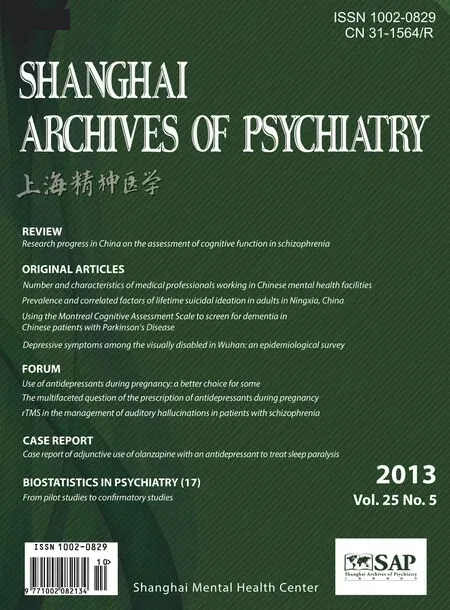Case report of adjunctive use of olanzapine with an antidepressant to treat sleep paralysis
Jinfeng DUAN, Wanli HUANG, Mincong ZHOU, Xujuan LI, Wei CAI*
?Case report?
Case report of adjunctive use of olanzapine with an antidepressant to treat sleep paralysis
Jinfeng DUAN, Wanli HUANG, Mincong ZHOU, Xujuan LI, Wei CAI*
1. Introduction
Sleep paralysis (SP) is one of several relatively common sleep disorders. When individuals with SP are waking up or, less commonly, when they are falling asleep, they can experience episodes in which they are temporarily conscious but not able to move or speak for several seconds to several minutes.[1]Breathing and eye movements are not affected but the inability to control one’s movements is often associated with extreme anxiety, phobia, nervousness, restless and, sometimes,hallucinations. SP episodes are more likely to occur when affected persons sleep lying flat on their back.[2]In most cases the episodes are brief and infrequent but in some individuals the episodes can last longer (up to an hour) and it can be a recurrent, lifetime condition.Most researchers[3]believe that SP is associated with rapid eye movement sleep (REMS). The relatively high prevalence of depression in individuals with SP[4]has led some to suggest that it is an atypical symptom of depression or that it has a shared causal pathway with depression, a suggestion supported by studies showing that antidepressants can relieve the symptoms of SP in some, but not all, patients with SP.[5]Further research is needed to clarify the etiology and identify effective treatments for the condition, which can be quite disabling for some individuals. This case report is about an individual with chronic SP for whom adjunctive treatment with an antidepressant and olanzapine effectively eliminated the symptoms of SP.
2. Case history
A 68-year-old man reported symptoms of SP for more than 40 years. He initially experienced insomnia and nightmares after a traumatic event in which he became permanently deaf following an explosion that occurred while working as an artilleryman in the army. He subsequently developed episodes of SP that typically occurred around two to three o’clock in the morning;during these episodes he would be lucid but could not move or speak and experienced panic and a pressure on his chest for 10 minutes or longer.
During the first three decades after the explosion,the SP episodes only occurred about once a year, so he did not seek treatment. But over the six years prior to arrival at our clinic the SP episodes had become increasingly frequent - to a point where they occurred almost nightly - and lasted for up to one hour each time they occurred. The fear and feeling of helplessness while being conscious induced him to seek treatment.Initially seen at different general hospital outpatient departments, he was diagnosed with depression and treated with a variety of antidepressants including paroxetine, mirtazapine, venlafaxine, and duloxetine.These medications decreased the SP symptoms, but he continued to have residual symptoms so he eventually came to our psychiatric clinic. Prior to admission to our inpatient psychiatric service he had been taking duloxetine 60 mg/d and mirtazapine 45 mg/d for one year.
On admission the patient was a healthy male who was deaf and had well-controlled Type II diabetes. He reported no personal or family history of neurological or psychiatric disorders other than the frequent occurrence of sleep paralysis. He communicated clearly and did not report any symptoms of depression or anxiety.He stated that the SP episodes occurred almost every night, lasted from somewhat less than one hour, and were not associated with hallucinatory experiences. A baseline polysomnography (PSG) (while still taking the duloxetine and mirtazapine he had been using over the prior year) from 9 pm to 6 am with a total sleep cycle of 528.5 minutes included 48.5 m (9.2%) wakefulness,238.5 m (45.1%) Stageinon-rapid eye movement sleep (NREMS), 86.5 m (16.4%) Stage II NREMS, 21 m(4.0%) Stage III NREMS, and 134 m (25.4%) REMS. The polysomnographic record showed bursts of REMS with alpha waves characteristic of SP.
Given the long history of less than satisfactory treatment with a variety of antidepressant medications,we decided to try combination treatment of a selective serotonin reuptake inhibitor antidepressant (paroxitene 40 mg/d) with a nighttime dose of a sedating atypical antipsychotic (olanzapine 2.5 mg). The very first night after taking the olanzapine the patient reported that the SP symptoms had stopped. A repeat PSG examination one month after starting this treatment regimen found significant changes in his 9-hour (540 minute) sleep cycle: it included 4.5 m (0.8%) wakefulness, 219 m(40.6%) StageiNREMS, 220 m (40.7%) Stage II NREMS,26.5 m (4.9%) Stage III NREMS, and 70 m (13.0%) REMS.
Over the two years of follow-up as an outpatient the SP symptoms were completely absent while the patient used olanzapine. The patient complained of weight gain while on olanzapine so we tried to convert him to other atypical antipsychotic medications (quetiapine,ziprasidone, and aripiprazole), but he re-experienced symptoms of SP while using these medications so he was changed back to olanzapine, after which the SP symptoms again disappeared.
3. Discussion
Despite reports about the relationship of SP to depression and anxiety,[4]there is little research about the effect of antidepressants on the sleep architecture of patients with SP.[4,6]Before the patient described in this case report came to our hospital, he had taken antidepressant medicine for several years but no PSG examinations were conducted so the effect of these medications on his sleep architecture are unknown.However, the patient continued to report troubling symptoms of SP so we expect that monotherapy with antidepressants had relatively little effect on his sleep.Moreover, on admission to our hospital he had been on a regular regimen of duloxetine and mirtazapine for over a year but the PSG assessment showed severely disturbed sleep architecture and he reported almost nightly episodes of SP.
This 40-year history of sleep paralysis was terminated after the first dose of olanzapine. The result was confirmed by dramatic changes in the PSG (including decreased REMS and increased Stage III NREMS)one month after starting the atypical antipsychotic medication. Moreover, the patient remained symptomfree over two years of outpatient follow-up except when we attempted to convert him to another atypical antipsychotic medication. We have not been able to find other reports in the literature of the use of atypical antipsychotic medication for chronic, antidepressant resistant SP, but our finding supports the contention of Michele and colleagues,[7]that SP is not simply a motordissociative disorder.
Several previous studies,[8]none of which involve individuals with SP, have shown that atypical antipsychotic medication can have lasting effects on sleep, including increased overall sleep duration, enhanced sleep efficiency and decreased wakefulness. Studies report that clozapine, olanzapine, risperidone, paliperidone,and quetiapine improve sleep quality through their antagonistic effects on several receptors in the central nervous system, including the 5-HT (5-HT1 and 5HT2), dopamine (D1 and D2), histamine (H1),and noradrenaline (α1 and α2) receptors.[8,9]In 1990,Sharpley and colleagues[9]discovered a dose-response relationship between the dosage of medications that antagonize 5-HT2C receptors and increases in Stage III NREMS (i.e., slow-wave sleep). A similar study by Lindberg and colleagues[10]in 2002 found that olanzapine can help maintain normal sleep patterns and increase the length of slow-wave sleep by its antagonistic effect on 5-HT2C receptors. And a literature review by Landolt and collegues[11]that integrated findings of several studies which used PSG to monitor medication-induced changes in sleep architecture,confirmed the previous reports: inhibition of 5-HT(2A)and 5-HT(2C) receptors is related to prolonged slowwave sleep and enhanced slow-wave rhythm. The clear efficacy of olanzapine in this patient and the lack of efficacy of other atypical antipsychotic medications suggests that the mechanisms underlying the sleep disturbance associated with SP are somewhat different than the mechanisms underlying other types of sleep disorders.
Given the risk of metabolic syndrome and the other adverse effects of long-term treatment with atypical antipsychotic medications, the risks and potential benefits need to be carefully considered, but for patients with chronic SP use of atypical antipsychotic medication (particularly olanzapine) should certainly be considered if other treatments prove ineffective and if the symptoms are having a serious effect on the individual’s quality of life.
Acknowledgements
The patient described in this case report provided written consent to publish the report.
Conflict of interest
The authors report no conflict of interest.
1. American Academy of Sleep Medicine. International Classification of Sleep Disorders: Diagnostic and Coding Manual, 2nded. Chicago: American Academy of Sleep Medicine; 2005.
2. Cheyne JA. Situational factors affecting sleep paralysis and associated hallucinations: position and timing effects. J Sleep Res 2002; 11(2): 169-77.
3. Hufford DJ. Sleep paralysis as spiritual experience. Transcult Psychiatry 2005; 42(1): 11-45.
4. Mariana SC, Teppy Y, Laurel F, Emmanuel M. Depression:relationships to sleep paralysis and other sleep disturbances in a community sample. J Sleep Res 2007; 16: 297–312.
5. Stores G. Medication for sleep-wake disorders. Arch Dis Child 2003; 88(10): 899-903.
6. Sharpless BA, McCarthy KS, Chambless DL, Milrod BL, Khalsa S-R, Barber JP. Isolated sleep paralysis and fearful isolated sleep paralysis in outpatients with panic attacks. J Clin Psychol 2010; 66(12): 292-306.
7. Michele T, Pietro LR, Francesco M, Raffaele M. Sleep paralysis in narcolepsy: more than just a motor dissociative phenomenon? Neurol Sci. 2012; 33(1): 169–172.
8. Cohrs S, Rodenbeck A, Guan Z, Pohlmann K, Jordan W, Meier A, et al. Sleep-promoting properties of quetiapine in healthy subjects. Psychopharmacology 2004; 174(3): 421-429.
9. Sharpley AL, Solomon RA, Fernando AI, Da Rosa Davis JM,Cowen PJ .Dose-related effects of selective 5-HT2 receptor antagonists on slow wave sleep in humans.Psychopharmacology 1990; 101(4): 568–569.
10. Lindberg N, Virkkunen M, Tani P, Appelberg B, Virkkala J,Rimón R, et al. Effect of a single-dose of olanzapine on sleep in healthy females and males. Int Clin Psychopharmacol 2002; 17(4): 177-184.
11. Landolt HP, Wehrle R. Antagonism of serotonergic 5-HT(2A/2C)receptors: mutual improvement of sleep, cognition and mood? Eur J Neurosci 2009; 29(9): 1795-1809.
Sleep paralysis (SP) is a condition of unknown etiology that usually occurs when falling asleep or when awakening in which the individual remains conscious but is unable to control their voluntary movements. This case report is about a 68-year-old man with a 40-year history of symptoms of SP and associated panic attacks upon awakening. Neurological examination and neuroimaging identified no abnormalities. Five years before the current evaluation he had been diagnosed with depression and treated with various anti-depressants which ameliorated, but did not cure, his SP. However, this 40-year history of SP was abruptly terminated – and did not return over the subsequent two years—after adjunctive treatment with 2.5 mg olanzapine each night was added to his antidepressant.
10.3969/j.issn.1002-0829.2013.05.010
Department of Psychiatry, First Affiliated Hospital, Zhejiang University School of Medicine, Hangzhou, Zhejiang, China
*correspondence: caiw236@aliyun.com.cn

Dr. Duan graduated with a bachelor’s degree from Xinxiang Medical College in 2006 and received a master’s degree in Psychiatry and Mental Health from Zhejiang University School of Medicine in 2009.She has been working in the First Affiliated Hospital of Zhejiang University since her graduation in 2009.She is currently a resident psychiatrist. Her research interest is clinical research on depressive disorders and schizophrenia.
- 上海精神醫(yī)學的其它文章
- From pilot studies to confirmatory studies
- rTMS in the management of auditory hallucinations in patients with schizophrenia
- The multifaceted question of the prescription of antidepressants during pregnancy
- Use of antidepressants during pregnancy: a better choice for some
- Depressive symptoms among the visually disabled in Wuhan:an epidemiological survey
- Using the Montreal Cognitive Assessment Scale to screen for dementia in Chinese patients with Parkinson’s disease

